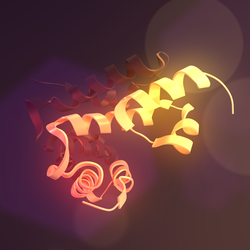PEG3
Paternally-expressed gene 3 protein is a protein that in humans is encoded by the PEG3 gene.[5][6] PEG3 is an imprinted gene expressed exclusively from the paternal allele and plays important roles in controlling fetal growth rates and nurturing behaviors as has potential roles in mammalian reproduction.[7] PEG3 is a transcription factor that binds to DNA [11-13] via the sequence motif AGTnnCnnnTGGCT, which it binds to using multiple Kruppel-like factors. It also regulate the expression of Pgm2l1 through the binding of the motif.[8]
Interactions
PEG3 has been shown to interact with SIAH2[9] and SIAH1.[9]
gollark: Yes, it deletes things.
gollark: ++delete the bee movie
gollark: Okay, fixed, I committed update.
gollark: ... please hold on.
gollark: Wait, is that still the Rust version?
References
- GRCh38: Ensembl release 89: ENSG00000198300 - Ensembl, May 2017
- GRCm38: Ensembl release 89: ENSMUSG00000002265 - Ensembl, May 2017
- "Human PubMed Reference:". National Center for Biotechnology Information, U.S. National Library of Medicine.
- "Mouse PubMed Reference:". National Center for Biotechnology Information, U.S. National Library of Medicine.
- Kim J, Ashworth L, Branscomb E, Stubbs L (August 1997). "The human homolog of a mouse-imprinted gene, Peg3, maps to a zinc finger gene-rich region of human chromosome 19q13.4". Genome Res. 7 (5): 532–40. doi:10.1101/gr.7.5.532. PMC 310658. PMID 9149948.
- "Entrez Gene: PEG3 paternally expressed 3".
- Michelle M. Thiaville; Jennifer M. Huang; Hana Kim; Muhammad B. Ekram; Arundhati Bakshi; Tae-Young Roh; Joomyeong Kim (December 31, 2013). "Peg3 Mutational Effects on Reproduction and Placenta-Specific Gene Families". PLOS ONE. 8 (12): e83359. doi:10.1371/journal.pone.0083359. PMC 3877027.
- Thiaville MM, Huang JM, Kim H, Ekram MB, Roh TY, Kim J (January 2013). "DNA-binding motif and target genes of the imprinted transcription factor PEG3". Gene. 512 (2): 314–320. doi:10.1016/j.gene.2012.10.005. PMC 3513644. PMID 23078764.
- Relaix, F; Wei X j; Li W; Pan J; Lin Y; Bowtell D D; Sassoon D A; Wu X (February 2000). "Pw1/Peg3 is a potential cell death mediator and cooperates with Siah1a in p53-mediated apoptosis". Proc. Natl. Acad. Sci. U.S.A. UNITED STATES. 97 (5): 2105–10. Bibcode:2000PNAS...97.2105R. doi:10.1073/pnas.040378897. ISSN 0027-8424. PMC 15761. PMID 10681424.
Further reading
- Relaix F, Wei XJ, Wu X, Sassoon DA (1998). "Peg3/Pw1 is an imprinted gene involved in the TNF-NFkappaB signal transduction pathway". Nat. Genet. 18 (3): 287–91. doi:10.1038/ng0398-287. PMID 9500555.
- Relaix F, Wei X, Li W, et al. (2000). "Pw1/Peg3 is a potential cell death mediator and cooperates with Siah1a in p53-mediated apoptosis". Proc. Natl. Acad. Sci. U.S.A. 97 (5): 2105–10. Bibcode:2000PNAS...97.2105R. doi:10.1073/pnas.040378897. PMC 15761. PMID 10681424.
- Kim J, Bergmann A, Stubbs L (2000). "Exon sharing of a novel human zinc-finger gene, ZIM2, and paternally expressed gene 3 (PEG3)". Genomics. 64 (1): 114–8. doi:10.1006/geno.1999.6112. PMID 10708526.
- Kohda T, Asai A, Kuroiwa Y, et al. (2001). "Tumour suppressor activity of human imprinted gene PEG3 in a glioma cell line". Genes Cells. 6 (3): 237–47. doi:10.1046/j.1365-2443.2001.00412.x. PMID 11260267.
- Hiby SE, Lough M, Keverne EB, et al. (2001). "Paternal monoallelic expression of PEG3 in the human placenta". Hum. Mol. Genet. 10 (10): 1093–100. doi:10.1093/hmg/10.10.1093. PMID 11331620.
- Yarden RI, Brody LC (2002). "Identification of proteins that interact with BRCA1 by Far-Western library screening" (PDF). J. Cell. Biochem. 83 (4): 521–31. doi:10.1002/jcb.1257. PMID 11746496.
- Johnson MD, Wu X, Aithmitti N, Morrison RS (2002). "Peg3/Pw1 is a mediator between p53 and Bax in DNA damage-induced neuronal death". J. Biol. Chem. 277 (25): 23000–7. doi:10.1074/jbc.M201907200. PMID 11943780.
- Strausberg RL, Feingold EA, Grouse LH, et al. (2003). "Generation and initial analysis of more than 15,000 full-length human and mouse cDNA sequences". Proc. Natl. Acad. Sci. U.S.A. 99 (26): 16899–903. Bibcode:2002PNAS...9916899M. doi:10.1073/pnas.242603899. PMC 139241. PMID 12477932.
- Gerhard DS, Wagner L, Feingold EA, et al. (2004). "The status, quality, and expansion of the NIH full-length cDNA project: the Mammalian Gene Collection (MGC)". Genome Res. 14 (10B): 2121–7. doi:10.1101/gr.2596504. PMC 528928. PMID 15489334.
- Mirey G, Chartrain I, Froment C, et al. (2006). "CDC25B phosphorylated by pEg3 localizes to the centrosome and the spindle poles at mitosis". Cell Cycle. 4 (6): 806–11. doi:10.4161/cc.4.6.1716. PMID 15908796.
- Dowdy SC, Gostout BS, Shridhar V, et al. (2005). "Biallelic methylation and silencing of paternally expressed gene 3 (PEG3) in gynecologic cancer cell lines". Gynecol. Oncol. 99 (1): 126–34. doi:10.1016/j.ygyno.2005.05.036. PMID 16023706.
- Chartrain I, Couturier A, Tassan JP (2006). "Cell-cycle-dependent cortical localization of pEg3 protein kinase in Xenopus and human cells". Biol. Cell. 98 (4): 253–63. doi:10.1042/BC20050041. PMID 16159311.
- Lim J, Hao T, Shaw C, et al. (2006). "A protein-protein interaction network for human inherited ataxias and disorders of Purkinje cell degeneration". Cell. 125 (4): 801–14. doi:10.1016/j.cell.2006.03.032. PMID 16713569.
This article is issued from Wikipedia. The text is licensed under Creative Commons - Attribution - Sharealike. Additional terms may apply for the media files.




